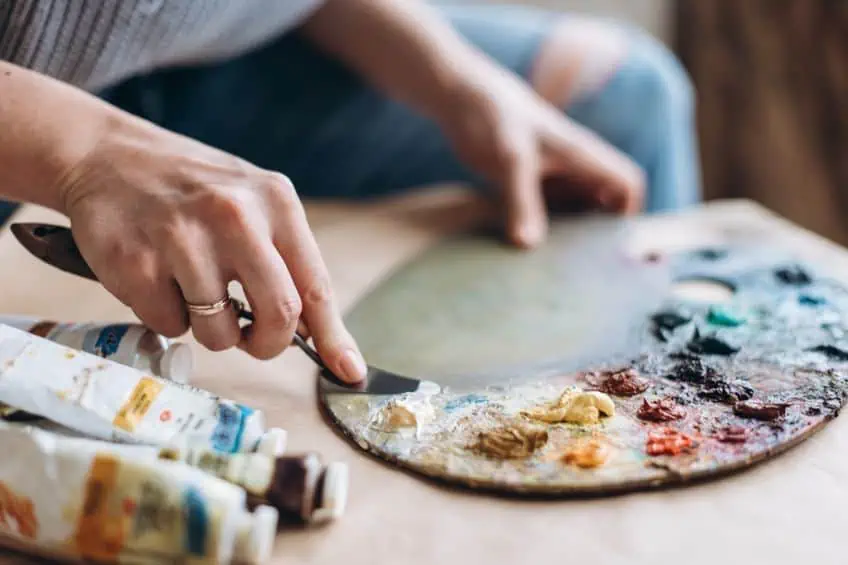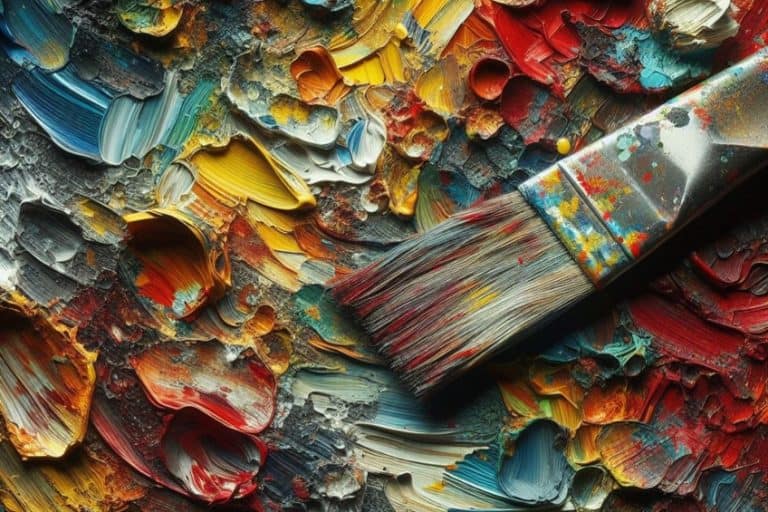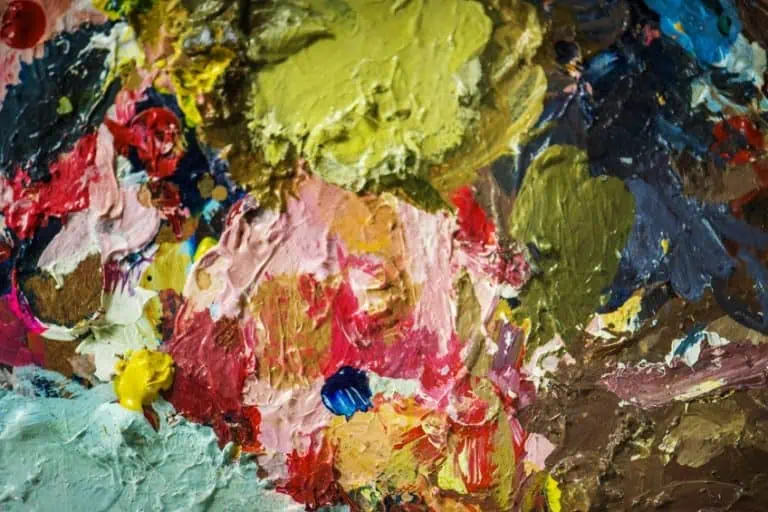Can You Mix Acrylic and Oil Paint? – Tips for Combining Media
This post may contain affiliate links. We may earn a small commission from purchases made through them, at no additional cost to you.
Acrylic paint and oil paint are two of the most popular and durable paint types on the face of the planet. They are capable of sticking to many surfaces, and they are available in a wide variety of colors. Since they are so popular, can you mix acrylic and oil paint? To answer this, we’ve prepared an in-depth look at both acrylic paint and oil paint, as well as their characteristics, to determine whether they’re compatible with one another or not.
Table of Contents
- 1 Understanding Acrylic Paint
- 2 Understanding Oil Paint
- 3 Difference Between Oil and Acrylic Paint
- 4 Can You Mix Acrylic and Oil Paint?
- 5 Benefits of Mixing Oil and Acrylic Paints
- 6 Frequently Asked Questions
- 6.1 Can You Mix Acrylic over Oil or Vice Versa?
- 6.2 How Do You Clean Brushes Used for Mixing Oil and Acrylic Paint?
- 6.3 Can You Use a Medium When Mixing Oil and Acrylic Paints?
- 6.4 How Long Does It Take for an Acrylic Oil Mixture to Dry?
- 6.5 Are There Any Risks When Mixing Oil and Acrylic Paint?
- 6.6 Is Acrylic Paint Oil-Based?
Understanding Acrylic Paint
To find out whether acrylic paint can be mixed with oil paint we need to understand what acrylic paint is made of, what it is used for, and some of the pros and cons associated with it. To speed up the learning process, we have created a short breakdown of some of these characteristics and how they affect the usage and applications of acrylic paint.
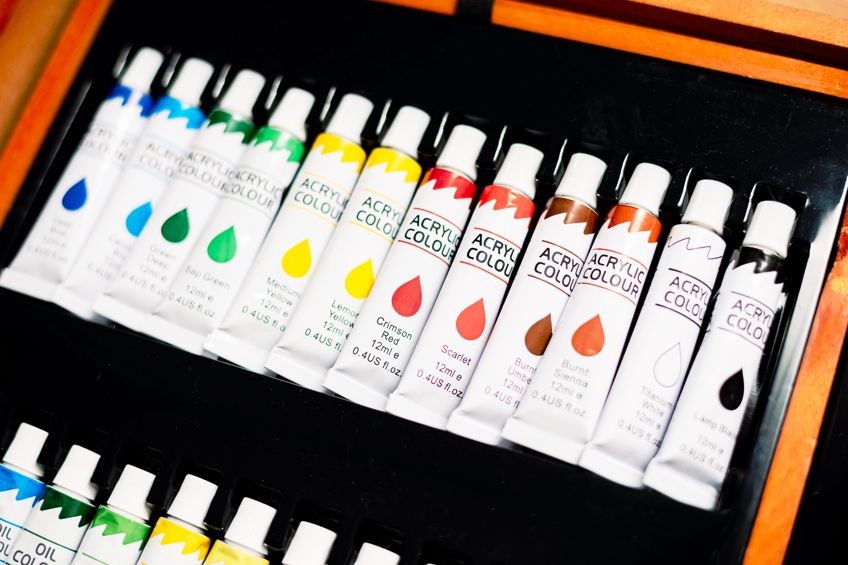
Properties of Acrylic Paint
Acrylic paint consists of pigment or dye that has been suspended in an acrylic resin or polymer binder, along with some solvents and stabilizers. When the paint is applied to a surface the solvent begins to evaporate leaving behind solidified polymer, which becomes your paint coating. This simple yet incredibly effective formula has led to acrylic paint becoming one of the most popular paint types in the world.
Acrylic paint is known for its vibrant synthetic color. However, compared to oil paints, it is more challenging to blend new colors when painting with acrylics.
Acrylic paints contain very few VOCs (volatile organic chemicals) too, which means they are far better for the environment and can be applied indoors, unlike oil-based paint. Acrylic paint is rather durable too, being resistant to the effects of impact, abrasion, heat, moisture, and even insect infestation and mold.

Advantages and Disadvantages of Acrylic Paint
Acrylic paint has many advantages, some of which we have already mentioned. Some notable advantages are its lack of VOCs, durability, and color quality, but it is also relatively inexpensive, easy to use, has an extended drying time, and is quite flexible too.
Some types of acrylic paint can even be reactivated once dried, but this does detract from their water resistance.
Acrylic paint is not without its disadvantages either. For example, some acrylics are less resistant to moisture, which can make them less versatile. The long drying times of many water-based acrylics can be very frustrating and they tend to be less durable than older pure acrylic paints. Modern water-based acrylic paints can also lose their ability to be reactivated over time.
- Contains few VOCs
- Resistant to impact, abrasion, heat, and moisture
- Fairly durable
- Bright and bold color
- Flexible
- Easy to use
- Much faster drying time than oil paint
- Some types can be reactivated with water
- Modern paints aren’t as water-resistant
- Water-based acrylic is not as durable as oil paint and pure acrylic
- Water-based variations can lose their ability to be reactivated
- Difficult to work wet on wet
- More challenging to blend colors
Common Uses for Acrylic Paint
We mentioned previously that acrylic paint is quite versatile, but how versatile is it? Acrylic paint is used on a wide variety of surfaces including brick, wood, leather, fabric, glass, cement, fabric, pottery, paper, and even board. There are very few surfaces that acrylic paint cannot stick to, and as long as the surface isn’t wet or greasy acrylic paint will get the job done. Here are a few examples of acrylic paint applications:
- Painting clothing and textiles
- Fine art
- Painting exterior and exterior walls
- Coating pottery
- Beautifying glass and ceramics
- Adding color to leather
- Crafting and recreation
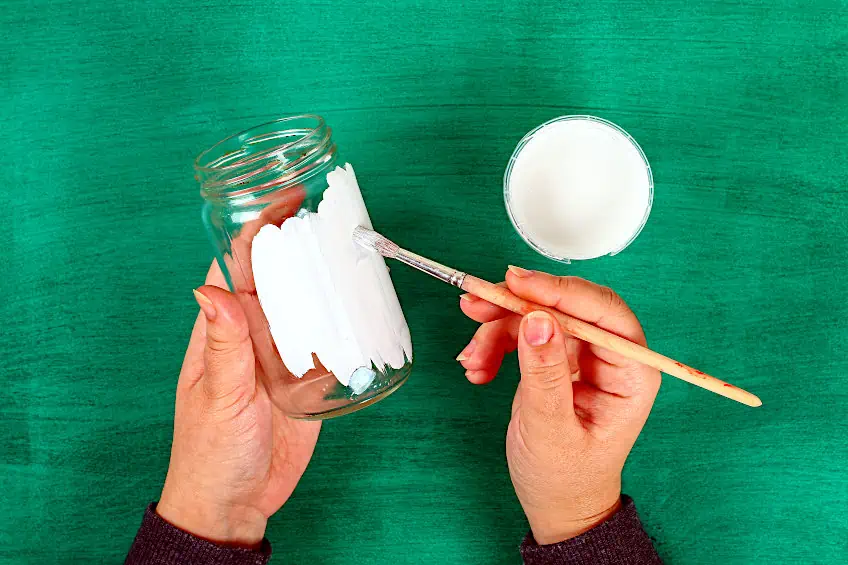
Understanding Oil Paint
Oil paint has been around for a long time and is believed to be one of the oldest paints in existence. It has been used by many cultures for numerous applications all over the world thanks to its inherent durability and its brilliant color. Can you mix acrylic paint and oil paint together then? Let’s have a look at some of the characteristics and find out how compatible they are.
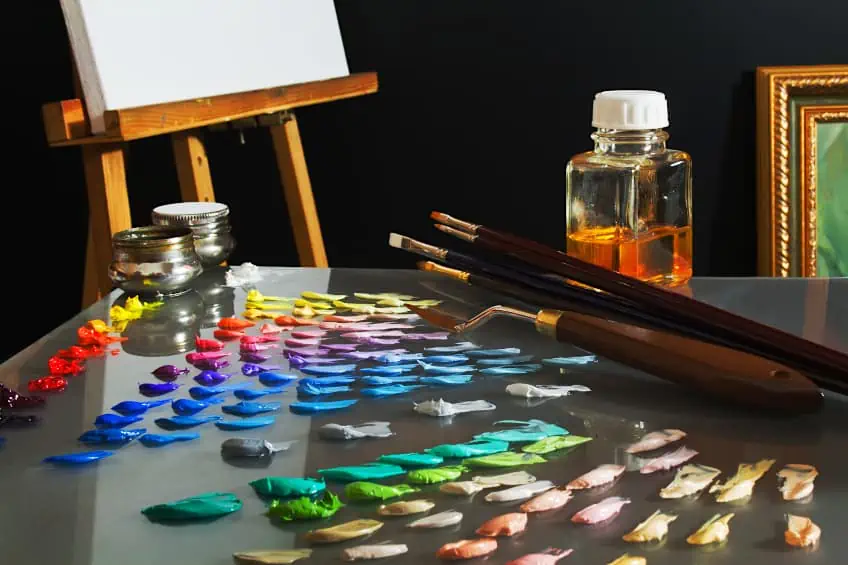
Properties of Oil Paint
Artist’s oil paint consists of pigment that has been suspended in a hardening oil like linseed. Hardening oil takes its name from its characteristic of hardening with prolonged exposure to air. While the paint itself is not dangerous, the mediums and solvents such as thinners and turpentine commonly used to dilute or thicken the paint can give off toxic fumes, so it is best to work in a well-ventilated area.
The paint itself has a smooth buttery texture that can easily be modified to a great extent through the addition of various additives.
Advantages and Disadvantages of Oil Paint
While not quite as versatile as acrylic paint, oil paint has many applications. As the color of the pigment is enhanced by the addition of oil, this paint type possesses a depth and range of colors.
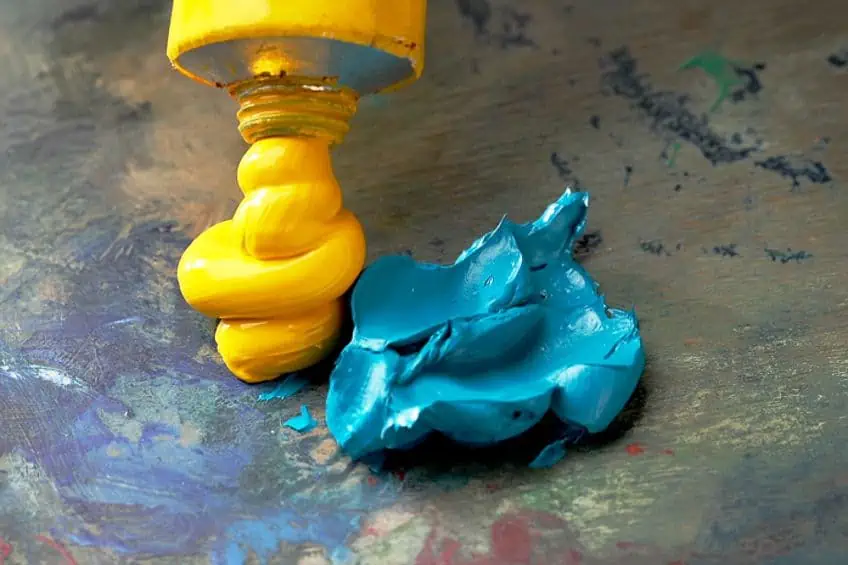
Oil paint is also incredibly durable, and provides a consistent color both when wet and dry. Galleries also advise artists that even though many of the greatest contemporary painters like David Hockney use acrylics, on average, art collectors will still pay more for a well-executed oil painting than any other medium.
The main drawcard when it comes to oil paint is the smooth texture of the paint, the extent to which it can be thinned and thickened, and the ease with which colors can be blended.
Oil-based paint has a number of disadvantages which has led to it being used less frequently outside of artistry. It has a long drying time, does not have as much elasticity as acrylic paint, and the solvents and thinners used with it produce toxic fumes that can cause health problems in the long run.
- Extremely durable
- Incredible depth of color
- Easy to change the consistency
- Resistant to impact, abrasion, heat, and moisture
- Easy to use
- Consistent color when wet and dry
- Ideal for working wet on wet
- Very easy to blend colors
- Very long drying time
- Very little elasticity once dried
- Thinners and solvents required produce toxic fumes
- Cannot be applied to wet surfaces
Common Uses for Oil Paint
Due to its high cost and extended drying time, artist’s oil paint is not as versatile as other paint types. However, if you are not in a rush you can use this paint on various materials including wood, metal, paper, parchment, board, canvas, and even Masonite!
- Fine art
- Furniture
- Signage
- Decorative artwork

Difference Between Oil and Acrylic Paint
All of this information can be difficult to wrap your brain around, so we’ve prepared a table showing you some of the key differences between acrylic and oil-based paint. While there are some overlapping characteristics these paints are fundamentally different, which can make them challenging to use simultaneously in most instances.
| Characteristic | Acrylic Paint | Oil Paint |
| Drying Time | 30 minutes | 24-48 hours |
| Mixing and Blending | Can only mix and blend for a short period | Very easy to mix and blend |
| Consistency and Texture | Paste-like consistency with a smooth, creamy texture whether grouped or spread out | Butter-like consistency with a smooth impasto texture in large amounts and canvas texture when spread out |
| Color Saturation | Medium to low level of color intensity when not diluted | High to medium level of color intensity when not diluted |
| Layering and Glazing |
|
|
Can You Mix Acrylic and Oil Paint?
Ideally, you would not mix two different types of paint together, particularly not an oil-based paint with any other type. Why? Different paint binders cannot be fully integrated into one another, especially when one of these is oil-based, since drying and adhesion will be adversely affected. So, if you are planning on using both the paint types in one painting, do not decant both on the same palette and do not attempt to blend them. However, it is possible to use oil paint and acrylics together in the same painting, but only under certain conditions.
You can safely apply acrylic paint over oil paint, but as a general rule, you should not paint with acrylics over oils.
Acrylic paint will easily adhere to most materials to create a non-porous surface, meaning that instead of spending a lot of time priming your canvas to prepare it for oil paint, you can immediately start your creative process by creating an acrylic underpainting instead. Once the acrylic has dried, you can safely apply as many layers of oil paint as your artwork requires, on top of it.

Oil paint not only dries very slowly, it can take months to fully cure, a process that involves the slow drying of the binder oil as it is exposed to air. By contrast, acrylic paint dries and cures relatively fast to create a flexible waterproof coating. This means that if you apply acrylic over oil paint that has not completely dried and cured, you will cut off the air and stop the drying process, effectively leaving your acrylic layer sitting on an oil slick. Over time, the acrylic will bubble and peel away, ruining your painting.
For oil paint to completely cure, its linseed base has to harden to the extent where it creates a non-porous film on the surface of the paint. In this scenario, a good quality acrylic paint will be more likely to adhere to a layer of oil paint. But keep in mind, that this could take weeks if not months, so if you really want to use acrylics over oils, you will have to be incredibly patient.
Benefits of Mixing Oil and Acrylic Paints
There are many benefits to mixing oil and acrylic paint despite the difficulty involved. Therefore, instead of asking “can I paint acrylic over oil”, you should ask yourself how doing might benefit you and what you could potentially create using both paint types. Here are a few benefits of mixing oil and acrylic paint in case you’re still on the fence.
Unique Effects and Textures
When using techniques such as impasto in your painting, oil can take very long to dry. If your are working on a commission with an impatient client, you can achieve the look of an impasto oil painting by first creating thick layers of paint in acrylics. These will dry far quicker, meaning that you can then apply your oil paint as a final layer to get that distinctive look in a fraction of the time.

The same applied to adding textural effects. Since acrylic easily adheres to most materials, you can use it on a variety of collage elements and even mix coarse materials such as sand into your paint.
When this acrylic layer has dried, you can then use oils on top of it without having to worry about anything flaking off.
Combining the Advantages of Both Paint Types
We mentioned previously that both paint types have their advantages and disadvantages, so why not combine the positive traits of both? Acrylic paint gets impressive coverage, features vivid synthetic color, and dries quickly.
This makes acrylic ideal for creating an underpainting over which the final layers of oil paint can be applied in a fraction of the time that doing the same, using only oil paint, would have taken.
When it comes to glazes and washes, oil paint is traditionally favored, as the pigments in the paint spread evenly when diluted, and the paint stays wet long enough to ensure seamless application. However, the invention of modern acrylic glaze mediums now allow artists to create glaze layers in acrylics with great success.
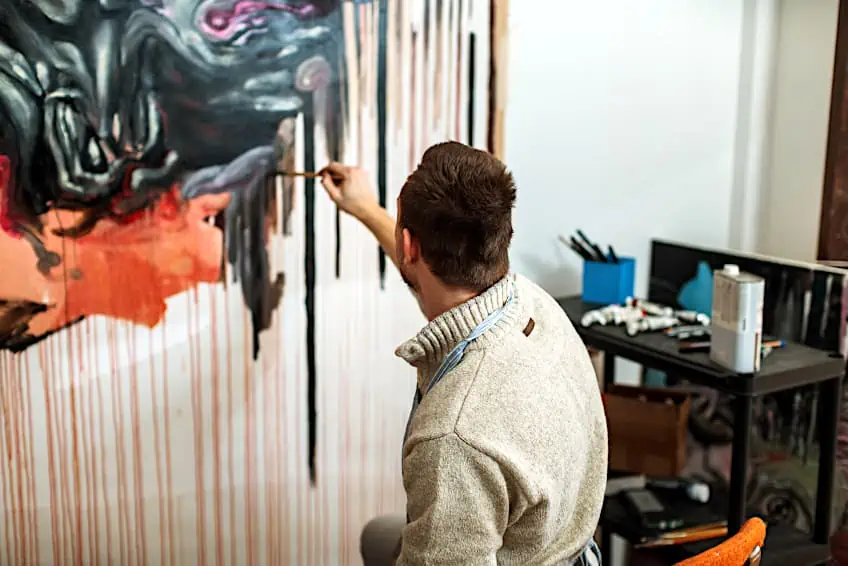
As acrylic lacks the yellowish tinge of the linseed oil base of oil paint, your glazes will be light and bright. Once your transparent glaze coats are in place, you can apply highlights and detail in oil paint to combine the best of both worlds.
In addition, the thinners and solvents required to produce glazes in oil produce toxic fumes, whereas acrylic glazing medium is safe to use.
Personalize Your Artistic Style
Since the material and color qualities of oil and acrylic paints differ, artists who wish to explore painting as non-illusory language of different types of surfaces can exploit these visual differences.
You will need to plan your work well though, ensuring that the areas where you wish to showcase the acrylic paint are applied first and then left untouched when you paint in oil.
If you are interested in exploring themes such as “decay” in your art, you can intentionally paint with acrylics over oils, as this layer will not adhere properly and over time, it will bubble and peel away. Keep in mind though, that if your artwork is meant for sale and is intended to change over time, you are required to inform the purchaser of this fact.

Supplementing for Deficiencies
As you will have seen, using acrylic as a base for oil painting can save you a lot of effort and time. By the same token, while acrylics allow for speed and feature bold synthetic color, oil is easier to blend and allows you far more time to change and correct your painting before drying. Some artists prefer to paint only in acrylics, while others swear by oils. If you know what you are doing, it is possible to use both.
To answer the question, yes, under certain conditions you can absolutely mix acrylic paint and oil paint if you know how to. It takes a bit of work to get it right, but we think you’ll agree that the result is often well worth it. There are many other paint types that can be mixed together, so don’t be afraid to get out there and experiment with them!
Frequently Asked Questions
Can You Mix Acrylic over Oil or Vice Versa?
While oil paint can be applied over acrylic paint once it has dried, acrylic paint cannot be applied over oil paint. Modern acrylic paints are often water-based, and since the water in these paints disperses once they dry, they cannot displace the oil paint when applied on top. Wet acrylic paint will not settle on top of oil paint due to its moisture content.
How Do You Clean Brushes Used for Mixing Oil and Acrylic Paint?
While both paints make use of pigments, their vehicles are different, so you might be confused about how to clean them. Solvents tend to break down the bonds in both acrylic and oil-based paints, so simply letting your brushes rest in turpentine and/or mineral spirits for an hour or two should do the job. Once your brushes are clean, be sure to give them a good wash with clean water before using them.
Can You Use a Medium When Mixing Oil and Acrylic Paints?
Unfortunately, there is no medium that can combine oil and acrylic paints. However, you can use an underglaze technique in which you apply acrylic paint first, wait for it to dry, and then apply your oil paint. This is considered to be the best way to ensure that your oil and acrylic paints mix on canvas and similar materials.
How Long Does It Take for an Acrylic Oil Mixture to Dry?
Acrylic paint and oil paint have vastly different drying times. How long does it take for a mixture of the two to dry then? A rough estimate would be around a day, especially considering that you would need to apply your acrylic paint first, wait for it to dry, and then apply your oil paint.
Are There Any Risks When Mixing Oil and Acrylic Paint?
Oil paint and acrylic paint are designed to be mixed, but a few things could still go wrong. The water inside your acrylic paint could displace your acrylic paint, both paints could fail to dry, and there is a possibility that both paints simply fail to adhere correctly.
Is Acrylic Paint Oil-Based?
Originally, acrylic paint consisted of pigment suspended in acrylic polymer. Modern acrylic paints, on the other hand, are typically water-based, none of which contain any oil. Therefore, there are definitely no oil-based acrylic paints, but there are oil-based paints that consist of water-based oil!
In 2005, Charlene completed her wellness degrees in therapeutic aromatherapy and reflexology at the International School of Reflexology and Meridian Therapy. She worked for a company offering corporate wellness programs for several years before opening her own therapy practice. In 2015, she was asked by a digital marketer friend to join her company as a content creator, and it was here that she discovered her enthusiasm for writing. Since entering the world of content creation, she has gained a lot of experience over the years writing about various topics such as beauty, health, wellness, travel, crafting, and much more. Due to various circumstances, she had to give up her therapy practice and now works as a freelance writer. Since she is a very creative person and as a balance to writing likes to be active in various areas of art and crafts, the activity at acrylgiessen.com is perfect for her to contribute their knowledge and experience in various creative topics.
Learn more about Charlene Lewis and about us.
